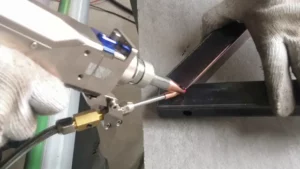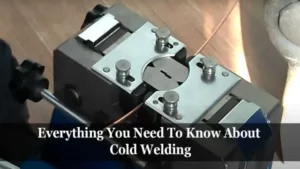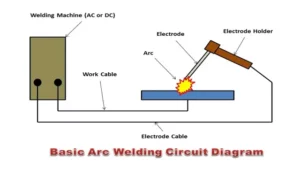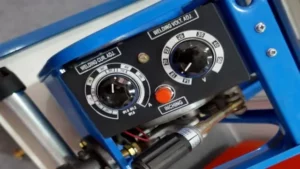Are you struggling with inconsistent TIG welds and wondering what could be causing the issue? Perhaps it’s time to take a closer look at your welding machine. Even with the perfect welding technique, a poorly calibrated machine can ruin your welds. So, how do you ensure that your TIG welding machine is set up to deliver the best results possible? In this blog post, we will dive into the world of TIG welding machines, exploring the process of adjusting them for optimal performance.
Think of it as tuning up your car before hitting the road. With a little guidance, you can learn to fine-tune your TIG welding machine and take your welds to the next level. So, grab your helmet and let’s get started!
Getting Started
Adjusting your TIG welding machine can be a bit intimidating at first, but with a little practice, you’ll find that it’s actually quite simple. The first thing to consider is your amperage settings. This will vary depending on the thickness of the metal you’re welding, but a good rule of thumb is to start with a low amperage setting and gradually increase it until you achieve a smooth, consistent weld.
Next, you’ll want to adjust your gas flow rate. Too much gas can cause turbulence and create imperfections in your weld, while too little gas can lead to oxidation and other issues. Experiment with different flow rates until you find the sweet spot that works for you.
Finally, pay attention to your tungsten electrode. This small but vital component can have a big impact on the quality of your weld. Make sure it’s sharp and properly positioned, and don’t hesitate to replace it if it becomes damaged or contaminated.
With these basic adjustments under your belt, you’ll be well on your way to mastering the art of TIG welding!
Understanding Your TIG Welding Machine
Starting TIG welding can be intimidating, but with the right understanding of your TIG welding machine, you can create excellent welds. The first step is to familiarize yourself with all the parts and controls of the machine, including the power switch, foot pedal, amperage control, gas valve, and tungsten holder. It’s essential to understand how each component works for you to achieve optimal results.
Make sure to consult your machine’s manual before beginning your welding project to ensure you have a thorough understanding of the machine and its capabilities. By taking the time to familiarize yourself with your TIG welding machine, you’ll feel more confident and comfortable, setting yourself up for success in your welding endeavors.

Gathering Necessary Tools
If you want to gather the necessary tools, you need to first determine what tools you need for your specific task. Depending on what you are trying to achieve, you may need different tools than someone else. Think about what you will be doing and do some research to figure out what tools are essential.
Once you have a list of tools, you can start gathering them. Depending on what you need, you may already have some tools at home or you may need to purchase or borrow them. It’s important to make sure you have all of the necessary tools before starting your project to avoid frustration and delays.
Don’t forget to gather any safety gear you might need, such as gloves and goggles. With a little bit of planning, you can be sure you have all of the necessary tools to complete your project successfully.
Adjusting Your TIG Welding Machine Settings
When it comes to TIG welding, adjusting your welding machine settings correctly is the key to achieving a perfect weld. First, ensure that you have the appropriate tungsten size and material for your project. Then, adjust your amperage to suit the thickness of the metal you are welding.
A good starting point is 1 amp per thousandth of an inch of metal thickness. Next, adjust your arc balance to suit the type of metal you are welding. A balance setting of 70% electrode negative and 30% electrode positive is a good starting point for welding steel.
Finally, adjust your pulse settings if you want to achieve a more controlled weld. By adjusting your TIG welding machine settings correctly, you can achieve a clean and precise weld that will stand the test of time.
Adjusting Amperage
One of the essential aspects of TIG welding is adjusting the amperage. Amperage is the amount of electric current flowing through the welding machine, which determines the heat of the arc. If the amperage is too low, the weld may not penetrate the material adequately, while if it’s too high, it may cause porosity, cracks, or excess spatter.
The type and thickness of the metal, electrode size, and welding position determine the appropriate amperage level. Adjusting the amperage requires fine-tuning the TIG welding machine settings, which can be done using the control knobs or buttons available on the machine. It’s crucial to strike a balance between the amperage and other welding settings, such as the gas flow rate, pulse width, and frequency, to achieve a clean, consistent, and high-quality TIG weld.
Adjusting Balance Control
Adjusting balance control is an important aspect of TIG welding. In simple terms, balance control allows you to adjust the percentage of cleaning and penetration, which plays a key role in determining the quality of the weld. Too much cleaning can result in a lack of penetration, while too much penetration can lead to impurities and porosity.
So, how do you adjust your TIG welding machine settings to achieve the perfect balance? Well, it all depends on your welding project and the type of metal you are working with. Generally speaking, a balance setting of 60-70% cleaning and 30-40% penetration is a good starting point for most applications. However, it’s important to experiment with different settings and techniques to find what works best for you.
Remember, practice makes perfect, so keep honing your skills and don’t be afraid to try new things to improve your welding results.
Adjusting Frequency
Adjusting frequency is an important part of TIG welding that can greatly affect the quality of your welds. TIG welding requires a stable and consistent arc, which can be achieved by adjusting the frequency settings on your welding machine. Lower frequencies are better for welding thicker materials, while higher frequencies are ideal for thinner materials.
Burst frequency, on the other hand, controls the amount of cleaning action the arc produces, which helps prevent contamination and oxidation of the weld. It’s important to note that adjusting frequency can also affect the level of heat input, so it’s important to balance frequency with other settings like amperage and travel speed. By learning how to adjust the frequency settings on your TIG welding machine, you can achieve optimal results and produce high-quality welds every time.
Adjusting Post Flow
Adjusting your TIG welding machine settings is a critical skill that every welder needs to master for a smoother welding experience. The machine settings determine the current, voltage, and other parameters that affect the welding operation’s smoothness, consistency, and quality. It’s important to adjust the settings based on the welding job’s requirements, such as the thickness and type of the metal being welded.
The most common settings that welders adjust include the amperage, gas flow rate, tungsten electrode type and size, and the post-flow setting, which determines how long the gas continues to flow after the welding operation is complete. By skillfully adjusting these settings, welders can achieve the perfect balance of heat control, penetration, and weld bead appearance for a professional-looking finish.
Testing Your Adjustments
Adjusting your TIG welding machine can be a daunting task if you’re not familiar with the process. Once you’ve made the necessary adjustments to fit the job at hand, it’s important to test them to ensure they’re working properly. Start by examining the quality of your welds; if they appear too rough or jagged, your machine might be set to a too high amperage.
Alternatively, if your welds appear too thin or lack penetration, your machine’s amperage settings may be too low. Remember to also check the weld puddle’s size, which can indicate if your machine is producing too little or too much heat. Once you’ve made the appropriate adjustments, it’s important to test them on scrap workpieces.
These will help you gauge your machine’s performance, adjust accordingly and make any other changes in preparation for the task at hand. It’s always better to be overly prepared and flexible in your approach than to be caught unaware and waste valuable time.
Preparing Your Workpiece
Before starting a woodworking project, it’s crucial to ensure that your workpiece is prepared correctly. Testing your adjustments is an essential part of this. Properly calibrating your tools and equipment before use will save you time and ultimately lead to a better end product.
When making adjustments, always approach your workpiece with caution to prevent damage or injury. Take your time to make small adjustments to ensure accuracy and precision. Testing your adjustments may seem like a tedious step, but it’s well worth it to create the best possible outcome for your project.
By taking the time to ensure everything is properly adjusted, you’ll be able to focus on your project, knowing you’ve done everything you can to ensure success.
Welding and Evaluating Results
After welding, it is crucial to evaluate the results to ensure that adjustments have been made effectively. Testing is an essential step in the welding process, and it involves inspecting the welds for defects, such as cracks, porosity, or lack of fusion. A visual inspection can help identify any visible issues, followed by non-destructive testing techniques, such as radiography, ultrasonic testing, or magnetic particle inspection.
These tests are essential in determining the integrity of the weld and ensuring that it meets the required standards. It is essential to perform testing after making any adjustments to the welding process to ensure that the changes have been made correctly. This can help avoid any potential issues with the weld in the future, which may arise due to lack of proper inspection.
Additionally, testing provides an opportunity to identify areas for improvement in the welding process and make further adjustments as needed. By continually assessing the results and making necessary changes, welders can consistently produce high-quality welds that meet the required standards.
Final Thoughts and Tips for Success
Adjusting a TIG welding machine can be a tricky task, but with a few tips, you can master it like a pro. Firstly, ensure that you have the correct settings for your weld thickness and material type. This ensures that you won’t end up with a weak or brittle weld.
Once you have your settings, it’s time to adjust your foot pedal or hand control for amperage control. If you’re experiencing difficulty with overheating or lack of arc stability, then adjust your post-flow time to ensure that the tungsten is protected. Don’t hesitate to adjust your gas flow rate and electrode size as well.
These adjustments will ensure that your welding machine performs optimally, and you achieve the best results. Adjusting a TIG welding machine is a hands-on process that requires patience and practice. As long as you have the right settings and follow these tips, you’ll have a seamless welding experience.
Conclusion
In short, tweaking your TIG welding machine is a delicate dance that requires patience, precision, and a touch of wizardry. But fear not, with the right tools, a little know-how, and a bit of experimentation, you can unlock the full potential of your machine and achieve the perfect weld every time. So grab your goggles, turn up the AC current, and get ready to work some welding magic like a pro!”
FAQs
What are the recommended settings for TIG welding aluminum?
Recommended settings for TIG welding aluminum depend on the thickness and type of aluminum being welded. Typically, you will want to use alternating current (AC), and adjust the amperage and gas flow rate accordingly. Consult your machine’s manual or an experienced welder for specific recommendations.
How do I adjust the gas flow rate on my TIG welding machine?
Adjusting the gas flow rate on a TIG welding machine is typically done using a flowmeter or regulator. Turn the adjustment knob or screw to increase or decrease the gas flow. The ideal flow rate will vary depending on the type of metal being welded and your specific welding setup.
What causes tungsten contamination in TIG welding, and how can I prevent it?
Tungsten contamination in TIG welding is typically caused by improper tungsten grinding, incorrect electrode angle, or touching the electrode to the workpiece. To prevent contamination, use a dedicated tungsten grinder, maintain a consistent electrode angle, and avoid touching the electrode to the workpiece.
How do I choose the right tungsten electrode for my TIG welding project?
The type of tungsten electrode you choose for TIG welding will depend on the type of metal being welded, the amperage range of your machine, and your welding setup. Some common options include pure tungsten, thoriated tungsten, and ceriated tungsten. Consult a welding expert or your machine’s manual for specific recommendations.
What is the proper technique for holding the TIG welding torch?
The proper technique for holding a TIG welding torch involves holding the torch with a comfortable grip, using both hands for stability, and maintaining a consistent distance between the torch and the workpiece. Practice proper body position and movement to avoid fatigue and produce high-quality welds.
How do I diagnose and fix common TIG welding problems like porosity or lack of fusion?
Common TIG welding problems like porosity or lack of fusion can be caused by a variety of factors, including improper gas flow, welding speed, or electrode angle. To diagnose and fix these issues, try adjusting your settings or technique, or consult an experienced welder for advice.
Can TIG welding be used for welding thick materials like steel or stainless steel?
TIG welding can be used to weld thick materials like steel or stainless steel, but it may require specialized equipment and techniques. For thicker materials, it may be necessary to preheat the metal or use a multi-pass welding technique to achieve adequate penetration. Consult a welding expert for specific recommendations.






